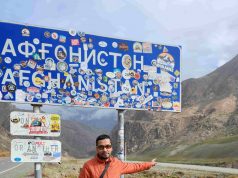 By: Ganesh Saili
By: Ganesh Saili
‘Retired soldiers will train our young boys on the use of weapons!’
I have often wondered who started this rumour and why. Years later, I have found that it was the biggest lie ever peddled.
Looking after the Media Cell of the Uttarakhand Joint Action Committee in Mussoorie, I met numerous out-of-station journalists, all asking the same question: ‘Where do we find the retired soldiers who are training the boys to use weapons?’
Of course, all the media wanted was a good picture! It would have made for great optics. However, it was to remain another door to which I could never find the key. It continues to baffle me. Perhaps it could have been a callous ploy invented by out-of-work politicians in the cynical belief that it would put more pressure on the then government.

Pic courtesy: author’s collection
Meantime, as loyal foot soldiers, on the second day of every month, our protest marches continued. Starting from Mullingar, we wound our way across the three-kilometre ridge to end at the Library Square, yelling slogans or screaming at the odd shop that was still open. Soon after, the only other sound was that of shutters being lowered.
Elsewhere, Diwakar Bhatt, who had been declared a field marshal by the legendary Inder Mani Badoni, climbed to the top of Khainth Parvat, famed for its fairies. No troopers could storm that hilltop in Tehri-Garhwal. What better place could there be to start a fast unto death?
Often in autumn, going past the slaughterhouses of Doiwala, you can see a large congregation of Steppe eagles—those birds of prey—testing the eddies of the breeze. When the time is right, the birds will float effortlessly on the thermals, going all over the mountain peaks, soaring beyond 25,000 feet in search of prey.
‘ We had planned to collect bags of offal to scatter in the fields adjoining the airport to deter any minister who decided to sneak in by air,’ the Field Marshal grins at the memory.

Pic courtesy: author’s collection
Indeed, retirees from the armed forces, the paramilitary, the SSB, Ladakh Scouts, ITBP, BSF, CISF, et. al. often choose to settle in the mountains. But in my travels, I have never met a single one who was teaching the young ones the path of violence. The people of Garhwal-Kumaon are generally peace-loving. Indeed, you will find nothing warlike about us. Down the ages, we have fought ‘the good fight’ and come back to eke out a living in our mountain homes. Out trekking on Independence Day, I still remember meeting an old man, proudly flaunting his crumpled INA uniform, emblazoned with pips, medals, and honours.
Yet, rumours followed me in October to the Oral Health Resort, where, in a dentist’s chair, I heard the gentle Dr. Gulshan Thukral tell me about a phone call he had received from friends about the mayhem in Muzaffarnagar beyond Roorkee. The next morning headlines called it the Rampur Tiraha firing. It is now a part of our history. Hundreds of demonstrators had set out on their way to Delhi to participate in the agitation at Rajghat on Gandhi Jayanti.
‘With no specific instructions from Lucknow,’ reminisces retired bureaucrat Rakesh Bahadur, the then district magistrate of Dehradun, ‘there was no point in stopping them. We let them pass through.’
Anyway, it was the buses that arrived last from the remote border districts that were singled out for special attention. Bazaar gossip had been thick with rumours that these buses were crammed with well-trained armed guerrillas.
Ganesh Kothari, a retired SDO Telecom, told me: ‘Just then, as luck would have it, some young agitators in a battered old car zipped past the buses lined up at the temporary barricade. They egged them on, and unthinkingly, the buses plunged through, easily shattering those flimsy barriers set up in Haridwar.’
An immense tragedy unfolded at Rampur Trijunction outside Muzaffarnagar. The police brutally lathi-charged the buses, leaving seven people dead. Four prosecutions were launched, but even after three decades, only one has been decided: two retired constables of the PAC, Milap Singh and Virendra Pratap, have been convicted.
‘Justice delayed is justice denied.’
Thirty years later, we’re still waiting.
Ganesh Saili, born and homegrown in the hills, belongs to those select few whose words are illustrated by their pictures. Author of two dozen books, some translated into twenty languages, his work has found recognition worldwide.








